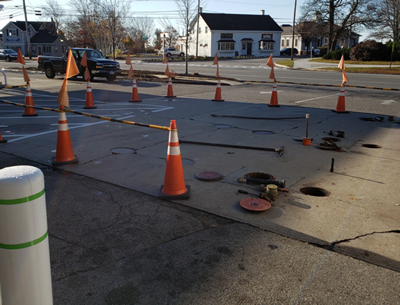Home → Air Quality → Programs → Air Toxics → NESHAP and MACT → Gasoline Distribution Area Source MACT
Gasoline Distribution Bulk Terminals, Bulk Plants, and Pipeline Facilities; and Gasoline Dispensing Facilities Rule
Gasoline Distribution Facilities
The Maine Department of Environmental Protection (DEP) adopted Chapter 118 Gasoline Dispensing Facilities Vapor Control to mirror the EPA’s National Emissions Standard for Hazardous Air Pollutants (NESHAP). The standard was created to reduce the amount of volatile organic compounds emitted to the atmosphere which lead to the formation of ground level ozone, an air pollutant linked to a variety of health risks.
Stage I Vapor Recovery
Stage I vapor recovery is a method created to control gasoline vapors that are released when gasoline is delivered to a tank. These vapors which would have historically been emitted to the atmosphere are returned to the tank truck in a closed loop system. Vapors are then transferred back to bulk terminals and controlled, when the tank truck refills. Both the tank trucks and facilities are subject to testing to check the functioning of the components of the Stage I systems.
Stage II Vapor Recovery
Stage II vapor recovery was repealed on January 1st, 2012. Stage II refers to the capture of fugitive emissions from the refueling of motor vehicles at a gasoline dispensing facility. The necessity for the Stage II system was minimized as new vehicles were equipped with onboard refueling vapor recovery systems, which significantly reduced fugitive emissions from the pump to the vehicle.

Testing for Stage I
Each owner or operator of a gasoline dispensing facility (GDF) is subject to Chapter 118. Stage I testing is required every 3 years if a facility's monthly throughput has ever historically exceeded 100,000 gallons. It is required that a facility conduct testing of their Stage I components in accordance with Chapter 118 and notify the department prior to testing.
Tank Tightness Testing
Chapter 120 requires that all tank trucks that transport and receive gasoline from a bulk terminal and/or plant be maintained leak-tight and must be tested and certified annually in accordance with the rule.
Maine DEP must be notified at least 5 days prior to performing Stage I testing, and EPA must be notified 60 days prior. Notification for Tank Truck Tightness Tests needs to be received by Maine DEP at least 24 hours prior to testing.
Notification Process

Please use this Stage I testing online notification form. The notification form must be submitted to the Department at least 5 working days prior to the planned test date so inspection by Department staff may be conducted. Notification of testing to the EPA is required 60 days prior to testing, use this mailable form to notify EPA (PDF).
Tank Truck Tightness Testing notification must be received 24 hours prior to testing. Use this Tank Truck Tightness Testing online notification form.
Bulk Terminals, Bulk Plants, Pipeline Facilities
Since the Maine regulations for gasoline bulk plants (see Chapter 118) include requirements for submerged fill, facilities in compliance with these requirements are not required to submit an initial notification or a notification of compliance status. Other subject facilities must submit their Notice of Compliance status by the compliance date or 60 days after completion of performance testing. If you are submitting an Initial Notification/Notice of Compliance Status contact your DEP regional office.
- EPA Initial Notification/Notification of Compliance Status Report for Bulk Gasoline Plants (DOC)
- EPA Initial Notification/Notification of Compliance Status Report for Gasoline Dispensing Facilities (DOC)
Maine Regulations for Gasoline Distribution and Other Resources
- Chapter 111—Petroleum Liquid Storage Vapor Control
- Chapter 112—Bulk Terminal Petroleum Liquid Transfer Requirements
- Chapter 118—Gasoline Dispensing Facilities Vapor Control
- Chapter 120—Gasoline Tank Truck Tightness Self-Certification
- Chapter 133—Petroleum Liquid Transfer Vapor Recovery At Bulk Gasoline Plants
- EPA Regulations
- EPA brochure (PDF)